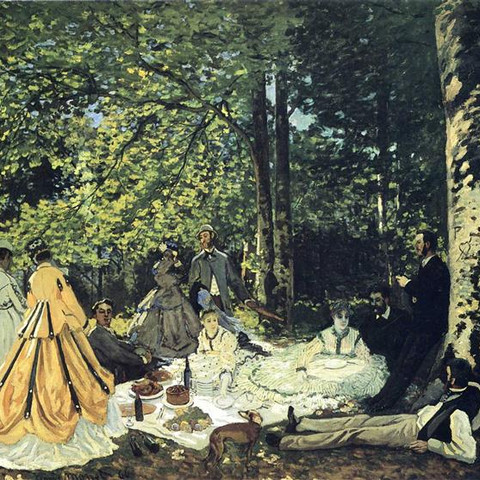Monet: Father of Impressionism
- Abby Grace Designs
- Aug 20, 2020
- 5 min read
Updated: Aug 23, 2020
Although most contemporary art does not resonate with me, Impressionism (arguably the first true "Modern Art" movement) is somehow different from the others. This art movement from the 19th and early 20th centuries exalts simplicity, fosters presence, and encourages mindfulness. In a time when the world is changing faster than ever before, Impressionism asks us to slow down and soak in the moment.
Many of my paintings and greeting cards are based on photographs of Claude Monet's gardens in Giverny! See Water Lilies and Water Lilies on a Cloudy Day. As a small thank you for reading, enjoy 10% of these two greeting card designs with the code 'MONET' at checkout!
Abby Wilfert, Water Lilies, 2017; Water Lilies on a Cloudy Day, 2018
Enjoy this escape to the French countryside with one of my favorite artists, Claude Monet!

Claude Monet in his studio
Around the world, Claude Monet is revered as the father of Impressionism, the eternal face of the late nineteenth century French art movement. His artistic style was experimental and, even over decades of production, far from stationary. Having lived in an industrial age, he witnessed and painted the fleeting essence of modernity. When he moved away from the city, he projected the same moment-in-time technique to scenes from nature. All of his works maintain a consistent interest in the effects of light and color on motifs, without regard for the individuality of the subject itself. The unique elements of Claude Monet’s groundbreaking artwork combine to holistically reflect the fundamental characteristics of Impressionism.
Claude Monet, Women in the Garden, 1867; Luncheon on the Grass, 1865
Monet began his career as an artist with a structured style, unlike the aesthetic for which he is now known. His oil paintings Women in the Garden from 1867 and Luncheon on the Grass from 1865 take on the color-blocking and rough paint application of Realism (Tucker, 17-20). Oftentimes, Monet’s early works imitated paintings by his Realism predecessor Edouard Manet (Tucker 22-24). Monet quickly became frustrated by the confinement of Realism, and poor critiques reinforced the assertion that he had not yet found his niche (Shackelford, 16). He eventually discovered both success and personal satisfaction with a looser style that allowed him to explore his interest in the visual effects of light, color, and the atmosphere.

Claude Monet, Impression, Sunrise, 1872
This new style came to fruition with Monet’s 1872 oil painting Impression, Sunrise (Tucker, 74). The work featured a simple harbor scene at sunrise, rich in color with hasty, arguably chaotic brushstrokes. Some critics compared the painting to an unfinished sketch, others said it was not a painting at all, but simply an “impression.” Monet adopted the term to name his art movement. Numerous artists joined Impressionism alongside Monet; among them, Edgar Degas, Pierre-Auguste Renoir, and Mary Cassatt. Together, the group developed works best known for their spontaneous compositions of everyday scenes from the modern city and the natural world. With Impression, Sunrise, Monet began a revolutionary art movement and his following works would later encapsulate Impressionism’s core principles.
Claude Monet, Boulevard des Capucines, 1873; Interior of the Gare Saint-Lazare, 1877
While living in Paris and traveling through France, Monet observed the constant movement of people. Europe came to life with speedy transportation systems and populated, bustling cities following the Industrial Revolution. Monet’s attempt at presenting a momentary view of this setting can be seen in both Boulevard des Capucines from 1873 and Interior of the Gare Saint-Lazare from 1877 (Tucker, 79, 94). The first painting depicts a busy street in Paris from a high perspective. Below, the unfocused shapes of civilians indicate motion, paired with a cropped and flattened composition, capture the scene as if it were a photograph from this period. Architect Baron Haussmann had recently modernized the Parisian city streets with wide boulevards and tall buildings. Both are clearly depicted in Boulevard des Capucines. These two technological advancements infuse the painting with a sensation of modernity. This idea is again presented in Interior of the Gare Saint-Lazare, a scene from an urban train station. The oncoming train is at the center of the painting, but the focus is rather on the modernism symbolized by the train. Monet began his Impressionist career by emphasizing the state of modernity around him through spontaneous paintings of everyday, urban life.

Claude Monet, Path through the garden at Giverny, 1902
Despite his enjoyment for experimenting with depictions of the modern world, Monet always felt drawn to nature. In 1883, he moved into a country home in Giverny and became “enchanted by the springtime exuberance of blossom and wild flowers in the village” (Holmes, 22, 24-26). A gardener at heart, Monet took on the massive project of designing and planting flower and water gardens around his new home. He intentionally planted a variety of flowers, so there would be something blooming at every time of the year. The flowers and water lilies from Monet’s own gardens became the new subjects for his old interest in capturing a fleeting moment in time. Monet believed “nature never stops,” yet, he aspired to stop it anyway (Gordon, 27). Instead of painting modern city streets, he painted nature as it could be seen in that moment, before the intensity or direction of the sunlight changed. His 1902 painting Path through the Garden at Giverny is an ideal example of his work during this period (Tucker, 179). Afternoon light washes over a mound of vibrant flowers. Consistent with the Impressionist belief that, as once said by Renoir, “no shadow is black [and] it always has a color,” the shadows on the ground are painted in deep green and purple. Likewise, the colors of the flowers change drastically depending on the amount of light cast over them. Monet’s return to nature provided him with the saturated subjects and access to natural light essential for creating many of his most iconic paintings.
Claude Monet, Wheatstacks series, 1890; Rouen Cathedral series, 1891-1892
Although his urban works from Paris contrast greatly with those from the Giverny countryside, Monet always made clear that the subject was not the purpose behind his paintings. He considered the motif “insignificant” because what he truly wanted to depict lied in the space between himself and the motif (Holmes, 136). He once said of his “unattainable” dream: “Other artists paint a bridge, a house, a boat; and that’s the end. They’ve finished. I want to paint the air which surrounds the bridge, the house, the boat; the beauty of the air in which these objects are located” (Holmes, 66). Monet’s 1890 Wheatstacks series and 1892-1894 Rouen Cathedral series, which lend no additional purpose to the subject matters, come closest to accomplishing this goal. Each of the roughly thirty Wheatstacks paintings portray one or two wheatstacks in a field during unique weather conditions or times of day (Tucker, 142-143). Similarly, Monet completed more than thirty paintings of the facade of the Rouen Cathedral in France at seemingly every change in light between sunrise and sunset (Tucker, 154-155). For Monet, the purpose of a motif was not to recreate reality, but to convey the effects of the world’s dynamic, abstract surroundings.
Where some Impressionist artists successfully depicted the moment-in-time principle in scenes of either the urban city or the natural countryside, Monet was accomplished in both. He also consistently disregarded motifs as the subjects of his works; instead, employing them in his experiments with light and color. Claude Monet can rightfully be called the father of Impressionism because he created artworks that coalesce into the foundational characteristics of this innovative art movement.
Works Cited
Holmes, Caroline. Monet at Giverny. Garden Art, 2011.
Shackelford, George T. M., et al. Monet: the Early Years. Kimbell Art Museum, 2016.
Tucker, Paul Hayes. Claude Monet: Life and Art. Yale University Press, 1995.
Gordon, Robert, and Sydney Eddison. Monet the Gardener. Universe, 2002.

Me painting Water Lilies 'alongside' Claude Monet
Thank you so much for joining me on this excursion into the foundations of Impressionism. From one art lover to another, enjoy 10% off of the Water Lilies and Water Lilies on a Cloudy Day greeting card designs until August 31, 2020! Don't forget to enter the code 'MONET' at checkout! Your support is deeply appreciated.
Also, let me know your thoughts on the "first Modern Art movement"! What impression does it leave on you?





















Comments